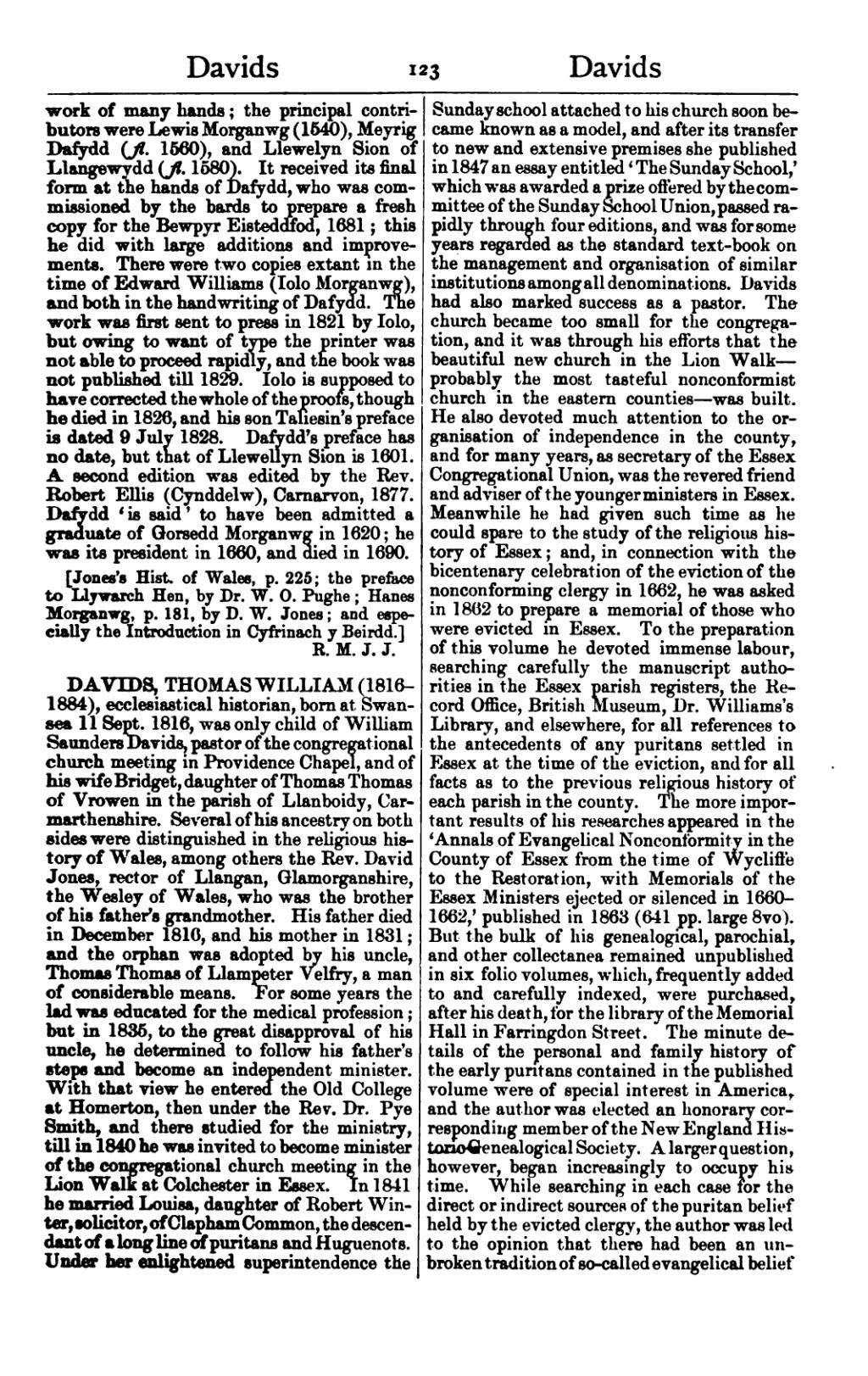work of many hands; the principal contributors were Lewis Morganwg (1540), Meyrig Dafydd (fl. 1560), and Llewelyn Sion of Llangewydd (fl. 1580). It received its final form at the hands of Dafydd, who was commissioned by the bards to prepare a fresh copy for the Bewpyr Eisteddfod, 1681; this he did with large additions and improvements. There were two copies extant in the time of Edward Williams (Iolo Morganwg), and both in the handwriting of Dafydd. The work was first sent to press in 1821 by Iolo, but owing to want of type the printer was not able to proceed rapidly, and the book was not published till 1829. Iolo is supposed to have corrected the whole of the proofs, though he died in 1826, and his son Taliesin's preface is dated 9 July 1828. Dafydd's preface has no date, but that of Llewellyn Sion is 1601. A second edition was edited by the Rev. Robert Ellis (Cynddelw), Carnarvon, 1877. Dafydd ‘is said’ to have been admitted a graduate of Gorsedd Morganwg in 1620; he was its president in 1660, and died in 1690.
[Jones's Hist. of Wales, p. 225; the preface to Llywarch Hen, by Dr. W. O. Pughe; Hanes Morganwg, p. 181, by D. W. Jones; and especially the Introduction in Cyfrinach y Beirdd.]
DAVIDS, THOMAS WILLIAM (1816–1884), ecclesiastical historian, born at Swansea 11 Sept. 1816, was only child of William Saunders Davids, pastor of the congregational church meeting in Providence Chapel, and of his wife Bridget, daughter of Thomas Thomas of Vrowen in the parish of Llanboidy, Carmarthenshire. Several of his ancestry on both sides were distinguished in the religious history of Wales, among others the Rev. David Jones, rector of Llangan, Glamorganshire, the Wesley of Wales, who was the brother of his father's grandmother. His father died in December 1816, and his mother in 1831; and the orphan was adopted by his uncle, Thomas Thomas of Llampeter Velfry, a man of considerable means. For some years the lad was educated for the medical profession; but in 1835, to the great disapproval of his uncle, he determined to follow his father's steps and become an independent minister. With that view he entered the Old College at Homerton, then under the Rev. Dr. Pye Smith, and there studied for the ministry, till in 1840 he was invited to become minister of the congregational church meeting in the Lion Walk at Colchester in Essex. In 1841 he married Louisa, daughter of Robert Winter, solicitor, of Clapham Common, the descendant of a long line of puritans and Huguenots. Under her enlightened superintendence the Sunday school attached to his church soon became known as a model, and after its transfer to new and extensive premises she published in 1847 an essay entitled ‘The Sunday School,’ which was awarded a prize offered by the committee of the Sunday School Union, passed rapidly through four editions, and was for some years regarded as the standard text-book on the management and organisation of similar institutions among all denominations. Davids had also marked success as a pastor. The church became too small for the congregation, and it was through his efforts that the beautiful new church in the Lion Walk—probably the most tasteful nonconformist church in the eastern counties—was built. He also devoted much attention to the organisation of independence in the county, and for many years, as secretary of the Essex Congregational Union, was the revered friend and adviser of the younger ministers in Essex. Meanwhile he had given such time as he could spare to the study of the religious history of Essex; and, in connection with the bicentenary celebration of the eviction of the nonconforming clergy in 1662, he was asked in 1862 to prepare a memorial of those who were evicted in Essex. To the preparation of this volume he devoted immense labour, searching carefully the manuscript authorities in the Essex parish registers, the Record Office, British Museum, Dr. Williams's Library, and elsewhere, for all references to the antecedents of any puritans settled in Essex at the time of the eviction, and for all facts as to the previous religious history of each parish in the county. The more important results of his researches appeared in the ‘Annals of Evangelical Nonconformity in the County of Essex from the time of Wycliffe to the Restoration, with Memorials of the Essex Ministers ejected or silenced in 1660–1662,’ published in 1863 (641 pp. large 8vo). But the bulk of his genealogical, parochial, and other collectanea remained unpublished in six folio volumes, which, frequently added to and carefully indexed, were purchased, after his death, for the library of the Memorial Hall in Farringdon Street. The minute details of the personal and family history of the early puritans contained in the published volume were of special interest in America, and the author was elected an honorary corresponding member of the New England Historic Genealogical Society. A larger question, however, began increasingly to occupy his time. While searching in each case for the direct or indirect sources of the puritan belief held by the evicted clergy, the author was led to the opinion that there had been an unbroken tradition of so-called evangelical belief
